Pad prik king is a stir fried red curry with long beans. This vegan pad prik king recipe can be made with tofu or seitan, depending on preference and/or what you've got buried in the depths of your fridge.
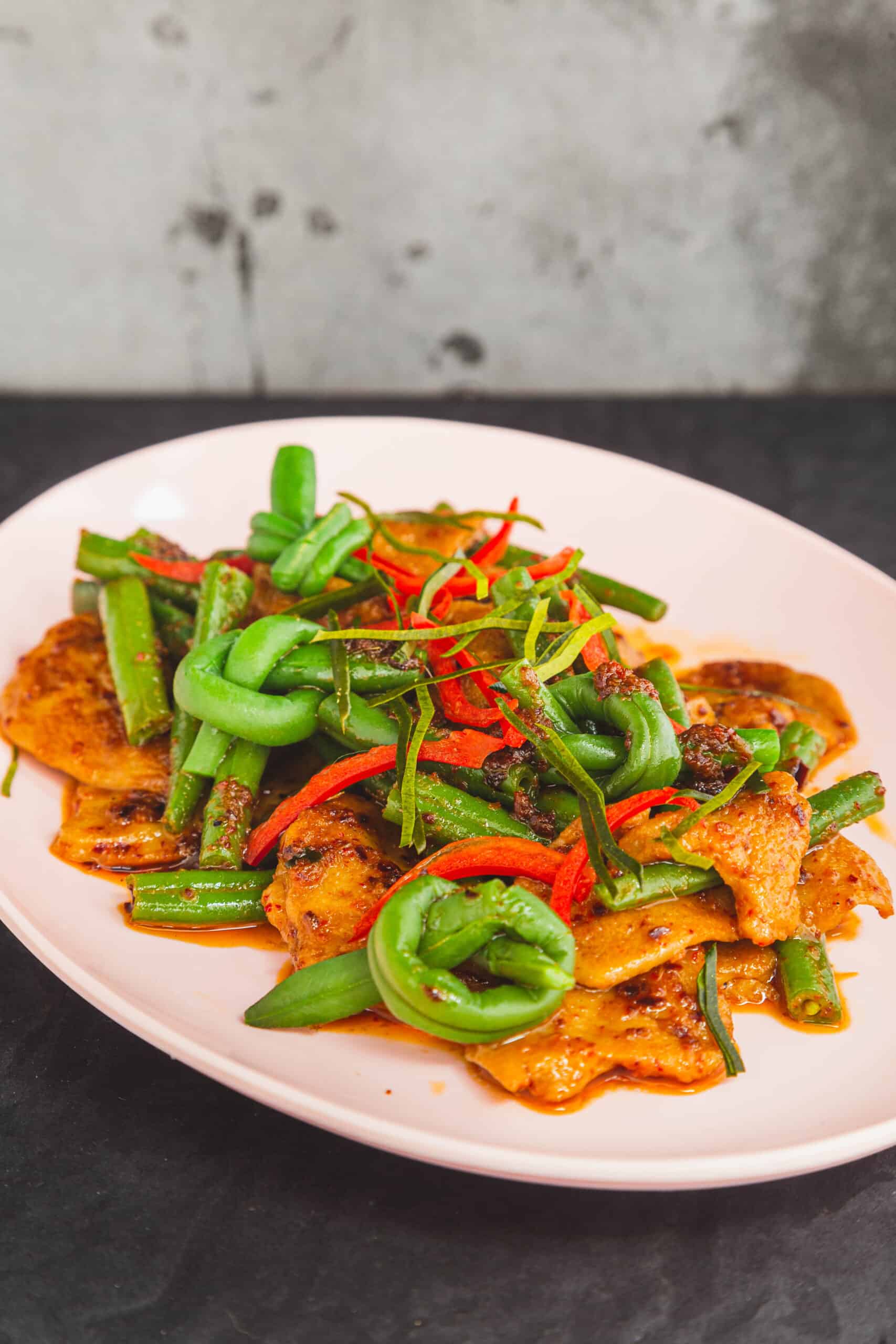
Because of its lack of soupiness, pad prik king is categorised as a dry curry.
Does pad prik king contain ginger?
Thai Thai word king translates to "ginger" in English, so you would be forgiven for assuming this ingredient to be present in pad prik king. I've heard whispers of claims pad prik king paste utilised ginger in times of yore but I've not found this to be the case in any recipes, both timeworn and modern, I've come across. Memory is fickle.
In trying to research the answer to this question, I came across a few Thai articles in which the writers explored the answer to this question by searching through older culinary volumes. The results seemed muddy and any evidence anecdotal.
Turning to my own library, I found that David Thompson, in his book Thai Food, dismisses the confusion with the explanation that in generations past any curry paste with dried red chillies would have been called prik king.
I also turned to culinary volumes penned by the person I trust and respect most with regards to Thai culinary research presented in English. As a linguist, the focus Leela Punyaratabandhu places on semantics always offers that little bit on top, providing meaning beyond the often unevidenced boilerplate master narratives that get passed around relentlessly.
According to Leela, in agreement with other authorities, the most likely explanation has its basis in linguistics. In her volume Simple Thai Food, she states "most food experts believe that the use of phrik khing here is the colloquially shortened form of the phrase thueng phrik thueng khing, which in the context of cooking can mean 'seasoned to the nth degree.'"
She offers a further possible explanation, which is that the ginger represents the chilli heat ceiling. Put another way, the spiciness from chillies should not go beyond the intensity of ginger.
Regardless of the interpretation, despite its confusing name, rest assured there is no ginger in pad prik king.
Pad prik king paste
As mentioned in my Thai curry paste primer, the type of red curry paste typically used for pat prik king is nam prik gaeng kua, but you can also use any store bought curry paste with good results. I've come across plenty of recipes that use nam prik gaeng pet, or red curry paste with spices like cumin and coriander included, and they will all work fine.
Is pad prik king spicy?
Whether or not pad prik king is spicy depends entirely on the curry paste you use to make this stir fry, but in general this dish errs on the side of sweetness over chilli heat. My advice for anyone who loves Thai food but is averse to very spicy curry is to make the curry pastes yourself so you can control the chilli content.
It's not traditional by any stretch of the imagination and purists may wince, but Korean gochugaru chilli powder can be a good alternative in chilli pastes where the diner doesn't favour much heat. To substitute, assume around ½ teaspoon chilli powder to equal one dried chilli in a recipe.
Circling (like a vulture) back to the original point, which is to cook a popular Thai dish, I hope you enjoy this easy vegetarian pad prik king recipe.
📖 Recipe
Vegan pad prik king ผัดพริกขิง
Ingredients
- 200 grams seitan or firm tofu see notes
- 2 tablespoons vegetable oil
- 2 tablespoons red curry paste see notes1
- 100 grams green or long beans cut into approx 1 ½ inch pieces
- 2-3 teaspoons palm sugar
- 1-2 teaspoons thin Thai soy sauce see notes2
- 2 makrut lime leaves deveined and sliced thinly
- long red chilli julienned (optional)
Instructions
If you're using seitan
- Slice the seitan into thin medallion-ish shapes.
If you're using tofu
- Slice the tofu into bite size rectangles around ¼ inch thick. For better texture, I recommend you boil the tofu prior to frying (read about why you should boil tofu). Bring a pot of reasonably salted water to the boil, add the tofu, and simmer for 10 minutes. Then strain the tofu, lay it on a tea towl, and pat it dry. Leave for 20 minutes or so to cool properly.
For the stir fry
- Heat the oil in a frying pan or wok to medium heat. Add the curry paste and cook for a couple of minutes, stirring to break it up (if it's a fresh curry paste, cook it until the raw garlic and shallot smells have dissipated).
- Knock the heat up to somewhere North of medium high and add the seitan or tofu. Stir fry for a couple minutes until you see some light browning.
- Add 2 tablespoons of water or stock, the beans, sugar and 1 teaspoon of the soy sauce. Stir to combine and have a taste of the sauce. Add the other teaspoon of soy sauce you favour more salt.
- Continue to cook for 2-3 more minutes. The beans should still have some crunch left in them. Serve garnished with lime leaves and chilli alongside steamed jasmine rice.
Notes
- For this recipe I use this red curry paste recipe, but storebought pastes will also work. Be mindful that salt contents vary between different curry pastes, so you may need to adjust for this by using more or less soy sauce in the recipe.
- Not all soy sauces are made the same. While you can get away with using a Chinese or Japanese brand of soy sauce, I recommend using Thai soy sauce as that is what this recipe has been tested with. Read this Thai soy and seasoning sauce primer for more information.
I referenced a few cookbooks in this post, which I recommend highly to anyone interested in Thai cooking. Neither are vegan, but many recipes inside are easily veganised. These are unparalleled volumes founded on a staggering heft of research.

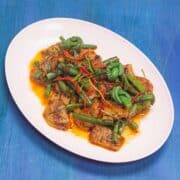
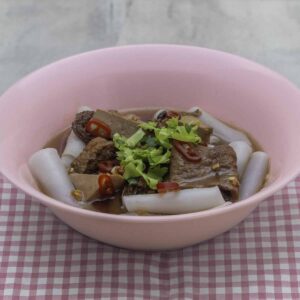
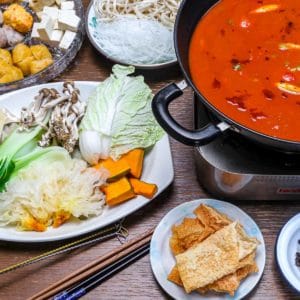
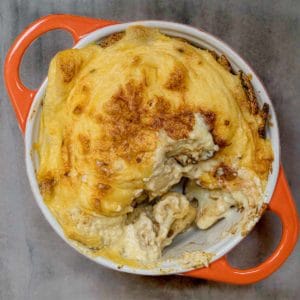
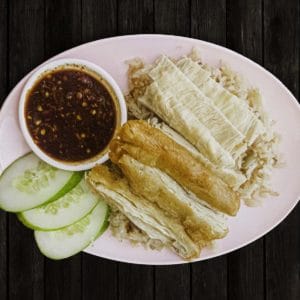
Brian says
The recipe doesn't mention when to add the lime leaves.
Kip says
Thanks for pointing that out. Fixed now.
Meera says
This is an amazing recipe! I followed it and the dish came out delicious !!thank you for sharing
I reserve the right to improve malicious and trollish comments.